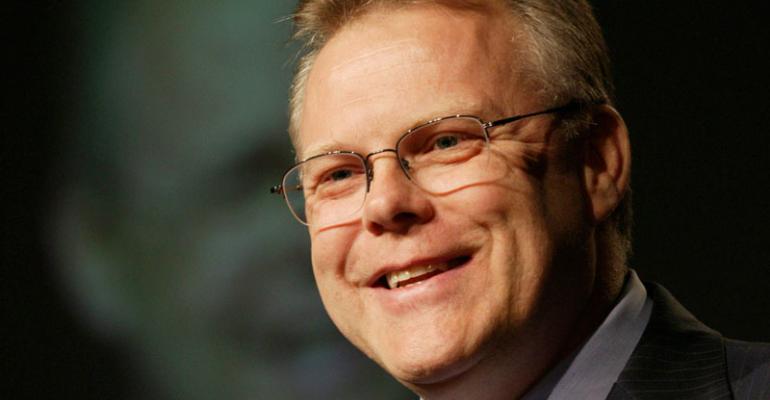Fisker Automotive founder Henrik Fisker says he now will focus on building brand awareness as executive chairman, while handing CEO duties to former Chrysler president Tom LaSorda.
Launching the California-based electric-car company has been “an amazing journey,” Fisker tells journalists today in a conference call. But “we are moving extremely fast; we need firecrackers in here every day. I couldn’t imagine a better person than Tom,” he adds.
The transition comes as Fisker’s U.S. operations are in limbo, having laid off workers at a Delaware plant destined to produce its second vehicle, dubbed Project Nina, a moderately priced extended-range electric vehicle.
Its maiden product, the $102,000 Karma, which is assembled in Finland by contract manufacturer Valmet, now is in launch phase in Europe and the U.S. Plans call for rollouts in China and the Middle East later this year.
LaSorda, who joined Fisker as vice chairman in late 2011, describes Fisker’s problems as “little challenges.” He tells journalists he met last week with U.S. Department of Energy officials as the auto maker seeks to renegotiate terms of government financing intended to boost green technologies.
Fisker has received $528.7 million in DOE loan guarantees but has drawn less than a third of that amount, about $190 million, because it recognized it would not meet agreed-upon product-launch deadlines.
Against this backdrop, the auto maker also has raised more than $860 million in private-equity financing and generated more than $100 million in revenue from Karma sales.
The 57-year-old LaSorda is confident, saying Fisker Automotive “has a bright future.” He also reminds that he has invested his own money in the auto maker.
LaSorda says his first priority is to balance the manufacturing operations by carefully matching Fisker’s production schedule with procurement.
Future products, which will be based on the Nina platform, “are just as drop-dead gorgeous as the Karma,” he adds.
Henrik Fisker says he first met LaSorda at the 2008 Detroit auto show. “His sleeves were still rolled up, like he was looking at some cars in the plant.”
The two struck up a friendship that prompted Fisker to call LaSorda last year – a conversation that led to the appointment of LaSorda, who hails from Windsor, ON, Canada, as vice chairman.
“I think I’ve been home once since I came out” to Fisker’s headquarters, he says. “I fell in love with the place.”
LaSorda’s roots in the auto industry run deep. His father, Frank, was head of a large United Auto Workers local in Windsor, before the establishment of the Canadian Auto Workers union.
Tom LaSorda is credited with instilling the concept of lean manufacturing at General Motors during a 23-year stint that saw him launch the GM-Suzuki joint venture dubbed CAMI, in Ingersoll, ON, and later rejuvenate Opel’s Eisenach assembly plant in Germany.
LaSorda joined DaimlerChrysler in 2000 as a senior vice president. By 2006, he had risen to CEO.
Following a 2007 shakeup that dissolved DaimlerChrysler and established Daimler and Chrysler as independent companies, LaSorda stayed on as president, a title he shared with former Toyota executive Jim Press. Ex-Home Depot CEO Robert Nardelli assumed the top job under a regime led by private-equity firm Cerberus.
LaSorda left the auto maker after it collapsed into bankruptcy in 2009 and re-emerged, backed by billions on government loans, under management control of Fiat. The Italian auto maker had asked LaSorda to stay on, but he declined.
Since then, LaSorda has been active as an industry consultant and in the venture-capital business. He expects to step down from his membership on the board of Toronto-based Electrovaya, a battery-technology company supplying Chrysler’s plug-in hybrid program.
The Karma’s six-figure starting sticker has been a lightning rod for critics of the DOE’s green-technology financing programs. But that is price of entry for innovation, Henrik Fisker says.
“You can’t start out with the absolute cheapest product,” he says, adding price reductions come with volume.
The Karma is “about lifestyle,” he says. Consumers who shell out for the luxurious 4-seater, which also is eligible for a $7,500 tax rebate, “want to adopt a different lifestyle where you actually show that you care about the environment.”
Project Nina output, now on hold, is destined for a former General Motors plant in Newark, DE. The site last produced the Saturn Sky, Pontiac Solstice and Opel GT roadsters, all of which vanished with GM’s 2009 restructuring.
Henrik Fisker says he will spend his time traveling to various Karma markets while remaining engaged in vehicle design. Before he founded Fisker Automotive, he designed cars for BMW and was lead designer at Aston Martin when the exclusive British brand was owned by Ford.
Fisker says his his long-range plans are to sell 100,000 vehicles annually. And 60% of those sales are expected to occur outside the U.S.
“We have big aspirations,” Fisker says. “So we need somebody like (LaSorda) to take us in that direction.”




